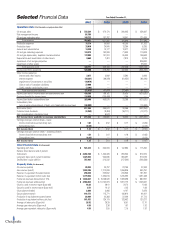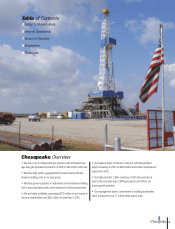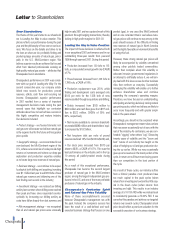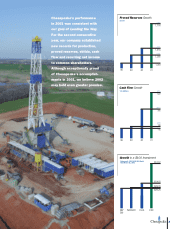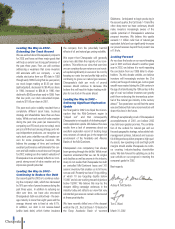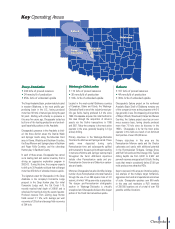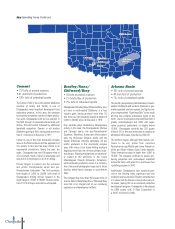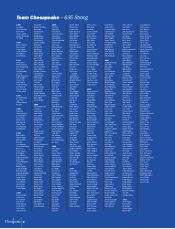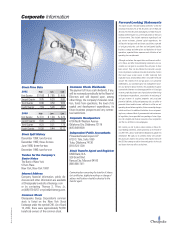Chesapeake Energy 2001 Annual Report Download - page 4
Download and view the complete annual report
Please find page 4 of the 2001 Chesapeake Energy annual report below. You can navigate through the pages in the report by either clicking on the pages listed below, or by using the keyword search tool below to find specific information within the annual report.
Letter to Shareholders
Dear Shareholders:
The theme of this year’s letter to our sharehold-
ers is
Leading the Way
in value creation. This
phrase reflects our performance during the past
year and the philosophy of how we run our busi-
ness. We focus on the details and strive to be
the best at what we do: profitably finding and
producing large amounts of natural gas, princi-
pally in the U.S. Mid-Continent region. We
believe superior results are achieved by focused
effort from talented professionals working on
high quality natural gas assets – attributes that
Chesapeake has in abundance.
Chesapeake’s performance in 2001 was consis-
tent with our goal of
Leading the Way
. For the
second consecutive year, our company estab-
lished new records for production, proved
reserves, ebitda, cash flow and recurring net
income. Chesapeake’s superior performance
in 2001 resulted from a series of important
management decisions made during the past
several years that highlight our contrarian
attitudes about how to best achieve success in
this highly competitive and mature industry.
Our decisions included:
•
Product strategy
– we favored domestic nat-
ural gas over oil because we believe natural gas
is the superior fuel for the future and has greater
price upside;
•
Geographic strategy
– we concentrated in our
own backyard, the Mid-Continent region of the
U.S., where our economies of scale provide high
returns on investment and where our deep gas
exploration and production expertise enables
us to locate large new reserves of natural gas;
•
Business strategy
– we continue to be equal-
ly adept at both drilling and acquiring, investing
over $1.1 billion last year to add 919 bcfe of new
natural gas reserves and delivering one of the
best finding cost records in the industry;
•
Investment strategy
– we reduced our drilling
activity last summer when drilling costs reached
their peak and have since responded counter-
cyclically by increasing our drilling activity as
costs have fallen sharply from last summer; and
•
Risk-management strategy
– we recognized
that oil and natural gas prices were unusually
high in early 2001 and we captured much of this
premium through hedging transactions, thereby
locking in high profit margins for 2001-03.
Leading the Way in Value Creation
The impact of these decisions is reflected both
in our exceptional 2001 performance and in our
outstanding three-year results from year-end
1998 through year-end 2001. During this period:
•Production increased from 130 bcfe to 161
bcfe, a compounded annual growth rate (CAGR)
of 7%;
•Proved reserves increased from 1,091 bcfe to
1,780 bcfe, a CAGR of 18%;
•Production replacement was 261% while
finding and development costs averaged only
$1.05 per mcfe for the 1,536 bcfe of new
reserves added through acquisitions and drilling;
•Ebitda increased from $183 million to
$620 million and cash flow grew from $115 mil-
lion to $522 million, CAGR’s of 50% and
66%, respectively;
•Net income available to common sharehold-
ers totaled $686 million and shareholders’ equi-
ty increased by $1.02 billion;
•Net long-term debt per mcfe of proved
reserves declined 18% from $0.83 to $0.68; and,
•Our stock price increased from $0.75 per
share to $6.61, a CAGR of 107%. This was the
best performance in the industry and in the top
10 among all publicly-traded stocks during
this period.
As a result of this exceptional performance,
Chesapeake has become the second largest
producer of natural gas in the Mid-Continent
region, among the largest independent gas pro-
ducers in the U.S. and one of the most profitable
producers of natural gas in the industry.
Chesapeake’s Contrarian Spirit
and Natural Gas Price Volatility
None of these accomplishments occurred
because Chesapeake’s management ran with
the pack. Instead, the company’s success has
been the result of a well-defined and well-
executed business strategy that focuses on one
product (gas), in one area (the Mid-Continent)
and on one consistent thesis: we believe natu-
ral gas prices will continue to stay strong in the
years ahead because of the difficulty in finding
new reserves of natural gas in North America
and the highly favorable environmental benefits
of using this fuel.
However, these strong natural gas prices will
likely be accompanied by volatility unmatched
among other publicly traded commodities.
Rather than complain about this volatility or
advocate intrusive governmental regulations in
an attempt to artificially reduce it, we will sim-
ply deal with this issue as we do other business
risks that confront us everyday. Successfully
managing this volatility will enable us to further
enhance shareholder value and continue
expanding the company’s operating margins.
Therefore, we have focused on understanding,
anticipating and acting decisively during natural
gas pricing cycles, which we believe are likely to
occur more frequently and with greater ampli-
tude in the years ahead.
Accordingly, you should not be surprised when
Chesapeake’s management team takes actions
that may seem occasionally out of sync with the
rest of the industry. As contrarians, we are com-
fortable “zigging” when others “zag”. Observing
twenty years of volatility and the “boom and
bust” nature of our industry has taught us the
value of hedging our oil and gas production dur-
ing the up cycles. While we may occasionally
give up some revenue in the boom portion of the
cycle, in return we will have more buying power
than our competitors in the bust portion of
the cycle.
As a result of these cycles, our industry suffers
from a historic paradox: most producers have
too much capital in the peak cycles (when
returns from investing are low) and too little cap-
ital in the down cycles (when returns from
investing are high). This results in an industry
average of a 10-15% ROI while we instead seek
to consistently generate a 25-30% ROI. If we
can solve this paradox and achieve our targeted
returns over several cycles, Chesapeake’s stock
price should reflect a premium valuation for the
successful execution of our business strategy.
2


